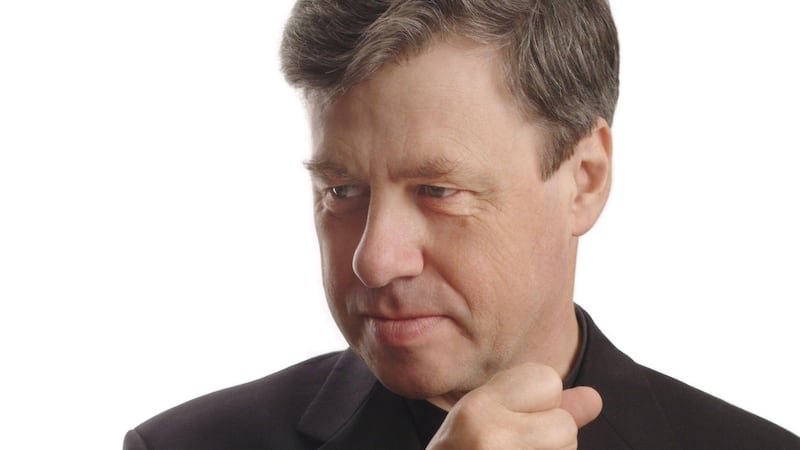Before Bach & After is the title of Chamber Choir Ireland's core concert series for the current season. Paul Hillier, the choir's conductor and artistic director, could hardly have given himself a much nicer or looser brief. He's got one of the great names of musical history to play around with and has carte blanche as to how far before and after Bach he needs to explore.
The four programmes take the opportunities to some of the available extremes. It’s true that only one of the four concerts includes works by women, and that the chosen composers are limited to individuals from Europe and North America. So there’s nothing from South America, where Brazil’s Heitor Villa-Lobos had one of the most fruitful of 20th-century creative encounters with Bach. But the second programme in the series, which was heard in Dublin on Saturday (and was also given in Kilkenny and Belfast) ranged from the 13th century (Adam de la Halle) through Machaut and Dufay, past Bach and Telemann and on to 21st-century Ireland for a triptych by David Fennessy.


Fennessy's triptych began with Letter to Michael in 2014, a piece Hillier liked so much at the time that it was he who suggested Fennessy should add to it. The performance he conducted on Saturday made clear why not just the music itself but also the idea behind it struck such a chord with him. Fennessy is not a composer who wants to set poetry to music. His choral works are anything but conventional in their approach to texts. To get started on a work, he has explained, "It might be a feeling or a situation or a mental state, often an extreme mental state, that might give me a lead in to a kind of physical result." What he's trying to describe is "basically how you might get to the state from which the body might produce the sound of singing." He looks for an emotionally heightened state to induce a physical state "from which the voice comes forth".
In Letter to Michael he found that in the writing of Emma Hauck (1878-1920), a German woman who was incarcerated because of acute schizophrenia and wrote letters to her husband which overlaid repetitions of "Komm" ("Come") or Herzensschatzi komm ("Come sweetheart") to the point of black illegibility. Fennessy's piece engages in similar dense layering, giving singers overlapping sliding lines to create a kind of perpetual, keening despair. It's as if he's imagined Hauck's head swarming with the words she wrote over and over and over, and has managed to recreate her never-ending sense of loss by turning those words into a kind of slowly heaving vocal mass for 16 solo voices. The effect of the music is disturbingly moving.
Never ending comes into both of the other pieces, too. Ne reminiscaris (2017) is about another extreme human experience, the kind of memory loss that can leave individuals living in what Fennessy calls "a permanent present-tense". That's his description of what happens to people who lose the ability to acquire new memories while retaining memories they already have. This work meets both the before and after criteria of Hillier's season title, the before Bach element provided by a fragment from Lassus's sixth Penitential Psalm, which Fennessy loops like an ear worm that simply won't go away.
The work is a long, slow morph, the words moving from “miserere” and “I am weak” to “I am awake,” and then beyond into balance and contentment. The music shifts almost imperceptibly, from a slow drift towards a blaze of sunlight and on to a kind of calmness and acceptance.
The final part of the work, Hashima Refrain, a co-commission by CCI and the Nederlands Kamerkoor, combines two texts, a graffiti poem from Japan's abandoned Hashima Island and the final entry of the 10th-century Sarashina Nikki, a memoir by a Heian Period lady-in-waiting. Hashima Refrain explores an all too well remembered past as experienced from a present that is somehow lost. It's an end of life perspective that is conveyed mostly in scurrying whispers with occasional moments of choral terra firma.
Under Hillier the choir sang as to the manner born, as well they might in music that was specifically written for them by a composer whose relationship with them goes back to 2002. That's when, in Choirland, Fennessy wrote a comic piece for them where the text begins with "Hi di di di didledi Hi di didledi Hi di di di didledi Hi di Hi." for the upper voices and "Whack!" for the lower ones. And, yes, "too ra loo" comes in later, too.
In spite of the competition from Bach and others, the complete Fennessy triptych stole the show on Saturday. The included Bach motets were uneven in performance, much more persuasive when the writing was chordal, more than a bit too highly-strung when the contrapuntal lines were in full flight against each other. And the rhythmic movement of the earliest pieces was a little too edgy, too, though it was a great pleasure to hear the choir tackle an area of repertoire that is all to infrequently celebrated in concert in Ireland. CCI's Before Bach & After series continues in February.















